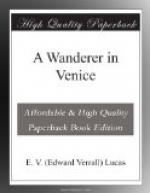Beyond S. Simeone, however, at the corner of the Rio della Croce, is a large and shady garden belonging to the Papadopoli family which may be visited on application. It is a very pleasant place.
CHAPTER XI
THE GRAND CANAL. IV: FROM THE STATION TO THE MOCENIGO PALACE, LOOKING TO THE LEFT
The Scalzi—The Labia Palace—The missing cicerone—Tiepolo and Cleopatra—S. Marcuola and Titian—A maker of oars—The death of Wagner—Frescoes on palaces—The Ca’ d’Oro—Baron Franchetti—S. Sebastian—The Palazzo Michiel dalle Colonne—A merry tapestry—A cardinal’s nursery—The Palazzo Lion—The Fondaco dei Tedeschi—Canova, Titian, and Byron.
Beginning at the Railway Station and going towards the Ducal Palace, the first building is the church of the Scalzi, by the iron bridge. The church is a very ornate structure famous for its marbles and reliefs, which counterfeit drapery and take the place of altar pictures; but these are an acquired taste. On the ceiling the brave Tiepolo has sprawled a vigorous illustration of the spiriting away of the house of the Virgin to Loreto, near Ancona.
Next come a row of shops, and, at the corner, the Lido hotels’ motor-launch office, and then several negligible decayed palaces. The first of any importance is the tall seventeenth-century incomplete Flangini with Michael Angelesque figures over the door. Then the Scuola dei Morti with its memento mori on the wall, and then S. Geremia: outside, a fine mass of yellow brick with a commanding campanile; inside, all Palladian coolness. Against the church a little house has been built, and at the corner of the Grand Canal and the Cannaregio is the figure of the Virgin. The great palace a little way down the canal which branches off here—the Cannaregio—is the Labia, interesting chiefly as containing the masterpiece of Tiepolo, unless one agrees with Symonds that his picture of S. Agnes in SS. Apostoli is his greatest effort. So far as I am concerned, Tiepolo painted largely in vain. I can admire the firm decision of his drawing and his skill in composition, but I can never lose the feeling that his right place is the wall of a restaurant or a theater curtain. Still, since at the Palazzo Labia we find him decorating a banqueting hall with a secular subject, all is well.
But first to get in, for the Labia, once so sumptuous, is now the home of a hundred poor families, and the daughter of the concierge whose duty it is to display the frescoes prefers play to work. For twenty minutes I waited in the gloomy, deserted hall while her father shuffles off in one direction and her mother in another, both calling “Emma!” “Emma!” with increasing degrees of fury. Small boys and girls joined in the hunt until the neighbourhood had no other sound. At last the little slovenly Emma was discovered, and having been well rated she fetched the key and led me up the grand staircase. Tiepolo chose two scenes from the life of Cleopatra, and there is no doubt that he could draw. In one the voluptuous queen is dissolving a pearl in a goblet of wine; in the other she and her infatuated Roman are about to embark in a splendid galley. The model for the wanton queen is said to have been a gondolier’s daughter named Cristina in whom the painter found all the graces that his brush required.




